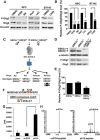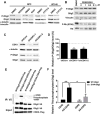A Sequentially Priming Phosphorylation Cascade Activates the Gliomagenic Transcription Factor Olig2
- PMID: 28355568
- PMCID: PMC5394178
- DOI: 10.1016/j.celrep.2017.03.003
A Sequentially Priming Phosphorylation Cascade Activates the Gliomagenic Transcription Factor Olig2
Abstract
During development of the vertebrate CNS, the basic helix-loop-helix (bHLH) transcription factor Olig2 sustains replication competence of progenitor cells that give rise to neurons and oligodendrocytes. A pathological counterpart of this developmental function is seen in human glioma, wherein Olig2 is required for maintenance of stem-like cells that drive tumor growth. The mitogenic/gliomagenic functions of Olig2 are regulated by phosphorylation of a triple serine motif (S10, S13, and S14) in the amino terminus. Here, we identify a set of three serine/threonine protein kinases (glycogen synthase kinase 3α/β [GSK3α/β], casein kinase 2 [CK2], and cyclin-dependent kinases 1/2 [CDK1/2]) that are, collectively, both necessary and sufficient to phosphorylate the triple serine motif. We show that phosphorylation of the motif itself serves as a template to prime phosphorylation of additional serines and creates a highly charged "acid blob" in the amino terminus of Olig2. Finally, we show that small molecule inhibitors of this forward-feeding phosphorylation cascade have potential as glioma therapeutics.
Keywords: CDK; CK2; GSK3; NPCs; Olig2; casein kinase 2; cyclin-dependent kinase; glioma; glycogen synthase kinase 3; neural progenitor cells; phosphorylation; protein kinase.
Copyright © 2017 The Author(s). Published by Elsevier Inc. All rights reserved.
Figures







Similar articles
-
Olig2 SUMOylation protects against genotoxic damage response by antagonizing p53 gene targeting.Cell Death Differ. 2020 Nov;27(11):3146-3161. doi: 10.1038/s41418-020-0569-1. Epub 2020 Jun 1. Cell Death Differ. 2020. PMID: 32483381 Free PMC article.
-
Harnessing OLIG2 function in tumorigenicity and plasticity to target malignant gliomas.Cell Cycle. 2017 Sep 17;16(18):1654-1660. doi: 10.1080/15384101.2017.1361062. Epub 2017 Aug 14. Cell Cycle. 2017. PMID: 28806136 Free PMC article. Review.
-
Cyclin-dependent kinase (CDK) phosphorylation destabilizes somatic Wee1 via multiple pathways.Proc Natl Acad Sci U S A. 2005 Aug 16;102(33):11663-8. doi: 10.1073/pnas.0500410102. Epub 2005 Aug 5. Proc Natl Acad Sci U S A. 2005. PMID: 16085715 Free PMC article.
-
Disruption of CK2beta in embryonic neural stem cells compromises proliferation and oligodendrogenesis in the mouse telencephalon.Mol Cell Biol. 2010 Jun;30(11):2737-49. doi: 10.1128/MCB.01566-09. Epub 2010 Apr 5. Mol Cell Biol. 2010. PMID: 20368359 Free PMC article.
-
Casein Kinase II (CK2), Glycogen Synthase Kinase-3 (GSK-3) and Ikaros mediated regulation of leukemia.Adv Biol Regul. 2017 Aug;65:16-25. doi: 10.1016/j.jbior.2017.06.001. Epub 2017 Jun 13. Adv Biol Regul. 2017. PMID: 28623166 Free PMC article. Review.
Cited by
-
Olig2 SUMOylation protects against genotoxic damage response by antagonizing p53 gene targeting.Cell Death Differ. 2020 Nov;27(11):3146-3161. doi: 10.1038/s41418-020-0569-1. Epub 2020 Jun 1. Cell Death Differ. 2020. PMID: 32483381 Free PMC article.
-
GSK3β-driven SOX2 overexpression is a targetable vulnerability in esophageal squamous cell carcinoma.Oncogene. 2023 Jul;42(30):2297-2314. doi: 10.1038/s41388-023-02748-w. Epub 2023 Jun 22. Oncogene. 2023. PMID: 37349645
-
Galectin-3 Exerts a Pro-differentiating and Pro-myelinating Effect Within a Temporal Window Spanning Precursors and Pre-oligodendrocytes: Insights into the Mechanisms of Action.Mol Neurobiol. 2020 Feb;57(2):976-987. doi: 10.1007/s12035-019-01787-3. Epub 2019 Oct 25. Mol Neurobiol. 2020. PMID: 31654317
-
Molecular Control of Oligodendrocyte Development.Trends Neurosci. 2019 Apr;42(4):263-277. doi: 10.1016/j.tins.2019.01.002. Epub 2019 Feb 12. Trends Neurosci. 2019. PMID: 30770136 Free PMC article. Review.
-
A glial blueprint for gliomagenesis.Nat Rev Neurosci. 2018 Jul;19(7):393-403. doi: 10.1038/s41583-018-0014-3. Nat Rev Neurosci. 2018. PMID: 29777182 Free PMC article. Review.
References
-
- Berthet C, Aleem E, Coppola V, Tessarollo L, Kaldis P. Cdk2 knockout mice are viable. Curr Biol. 2003;13:1775–1785. - PubMed
-
- Bouvier C, Bartoli C, Aguirre-Cruz L, Virard I, Colin C, Fernandez C, Gouvernet J, Figarella-Branger D. Shared oligodendrocyte lineage gene expression in gliomas and oligodendrocyte progenitor cells. J Neurosurg. 2003;99:344–350. - PubMed
Publication types
MeSH terms
Substances
Grants and funding
LinkOut - more resources
Full Text Sources
Other Literature Sources
Molecular Biology Databases
Miscellaneous

